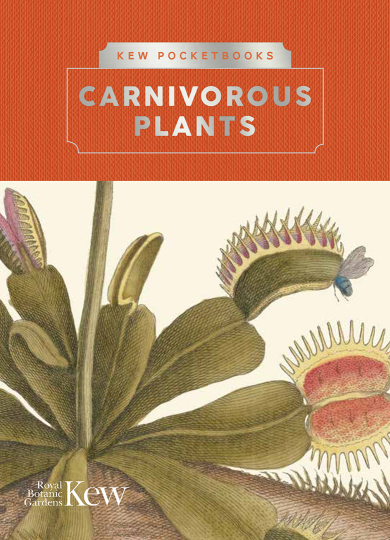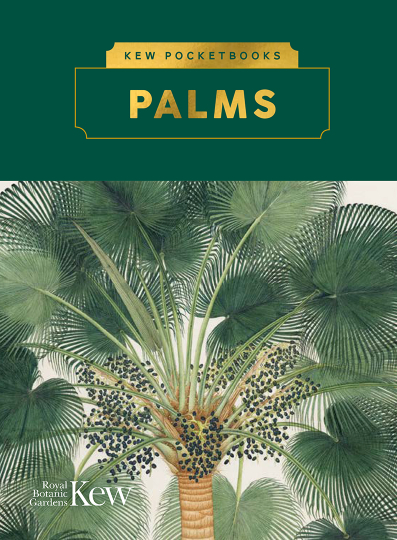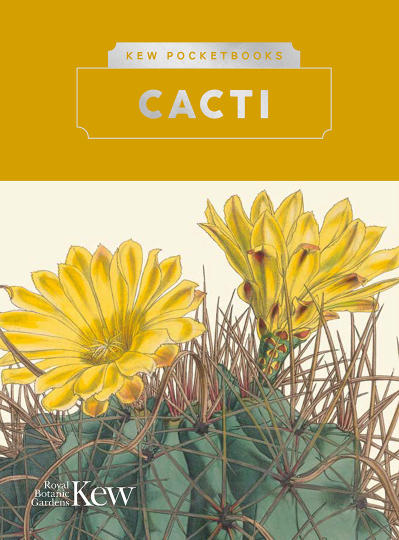This is the concluding post that looks at Kew’s Pocketbook series of illustrated plant books. The first post provided an overview of the collection, the second considered four of the titles in more detail. This third post further evaluates another quartet of volumes in that series.
By way of a general comment for the four titles considered in this post, none of them have any explicit indication of the sources for statements of fact made in the Introduction or the annotations to the illustrations. Onto this post’s quartet of titles…
Carnivorous plants, 2021.

Introduction by Chris Thorogood, curated by Lydia White.
From the Kew bookshop site, we are told that “Carnivorous plants are deadly beauties that trap, kill and consume everything from insects, spiders and crustaceans to lizards and mice, luring their prey in with specialised hairs, sweet nectar, bright colours, or the convenience of a toilet. 40 stunning botanical pairings* of this extraordinary group are showcased here, including the famous Venus flytrap, as well as pitcher plants and sundews” [quoted from here]. The Introduction provides a very good introduction to the biology of carnivorous plants, particular their diverse animal-trapping adaptations. However, Thorogood is silent on how the plants included in the volume were chosen. And it would be useful to know the thinking behind the way the plants are grouped in this book because the first eight numbered plants show – in order from number 1 – Sarracenia flava, Nepenthes northiana, Drosera capensis and D. spatulata, Pinguicula moranensis, N. ampullaria, S. minor, D. whittakeri, and S. purpurea.
As already mentioned [see Part 1], this title has two departures from what’s declared for the Kew Pocketbook series (see here). First, its Introduction is not contributed by an expert from Kew but by Chris Thorogood (Deputy Director and Head of Science at the University of Oxford Botanic Garden and Arboretum. Second, it doesn’t just include images from the collection at Kew, but several of Thorogood’s own – e.g. Heliamphora elongata (p. 30), Nepenthes lowii (p. 49), and N. rajah (p. 54), which source – Thorogood’s Weird plants – is disclosed.
A third departure from the series is the absence of any annotations about the illustrated carnivorous plants by the expert contributor – which is expected from the series’ publicity, “extended captions accompany each painting”. That’s a pity because it would be interesting to gain additional insights into the plants depicted from an acknowledged expert in the field [see here, and here, and see – and listen – here, hear, and hear, which would add considerably to the value and usefulness of the book.
For purposes of comparison with the Reaktion Books’ series, see Carnivorous plants by Dan Torre (which is listed as one of the Kew’s books items of Further Reading).
Festive flora, 2021.

Introduction by Kew ethnobotanist Mark Nesbitt, and curated by Nesbitt and Lydia White.
This book’s Kew site tells us that Festive flora “is a celebration of the plants integral to religious, cultural and national festivities around the world, used as decoration in wreaths, garlands and shrines, for their scent, and in festive recipes” [quoted from here] – which it is. Of all the titles in the Kew Pocketbook series this one probably has the most eclectic mix of plants, which includes: begonia; saffron; holly; olive; ginger; apple; date palm; turmeric; frangipani; lady’s bedstraw; toddy palm; cassava; and frankincense. The reason for that is that “the festive plants chosen for this book are reminders of just how deeply plant symbolism and rituals are embedded in human societies” (p. 6). However, and as Nesbitt acknowledges, “the European and North American Christmas features strongly, given its place as something of a global festival” (p. 8). But, “with help from Kew colleagues we have looked to other religions, places and times of year” (p. 8). Nesbitt’s always-interesting insights in the annotations add considerable value to this book. But, nowhere does he tell us what was the Druids’ use of mistletoe – as recorded by Pliny [the Elder (Jerry Stannard), or the Younger..?] – that has no connection with the English custom of kissing beneath the mistletoe; what was the use in “a very different context” (p. 9) to which Nesbitt alludes?
As highlighted in my appraisal of Mexican plants [see Part 2], Tagetes erecta is included here, in Festive flora, and in Mexican plants because of the plant’s association with the Mexican festival ‘Day of the Dead’. But, different images illustrate the same plant in the different books – an example of good curation?
Although the in-text annotation for Amaranthus cruentus refers to Mexico’s Day of the Dead holiday, this plant isn’t mentioned in Mexican plants. Date palm was also included in Festive flora with its connection to the Christian celebration of Palm Sunday and Jewish Passover. However, date palm is not one of the 40 numbered palms illustrated in Palms. [for more on this, see Palms below] With some cases of plants appearing in more than one of the Kew titles, and others just in one (but not also another where they’d seem likely), I’m wondering what criteria are used to justify selection of the 40 plants that are included within each title of the Pocketbook series. I couldn’t find a mention of this policy anywhere (although titles such as Houseplants do give some explanation of why it’s been illustrated with the plants it has); it would be really interesting to know. On the palm plus side, coconut (Cocos nucifera is featured in Festive flora (because of its association with fast-breaking at the end of Ramadan), and also appears as one of the numbered 40 palms in Palms (where it’s named as coconut palm).
Palms, 2020.

Introduction by Kew expert William J Baker, and curated by Lydia White.
Although this book “offers a snapshot into the diverse and beautiful world of palms, from desert island coconuts to house plant favourites”, and Baker “provides an overview of palms”, it doesn’t include the stated “detailed captions [to] accompany each painting”. That’s a shame because it would be interesting to gain additional insights into the plants depicted from an acknowledged expert in the field, and that would add considerably to the value and usefulness of the book – notwithstanding the fascinating – and passionately-written – introduction to fern biology and relationships to human penned by Baker in the Introduction. But, Baker does give some clue as to why the 40 palms were selected for the book which “demonstrates the wonders of palms” (p. 9).
The entry for date palm in the Index refers to p. 2. Page 2 has no text, but does show a half-page, black-and-white image of a group of people plus camels gathered near what may be date palms, with pyramids in the background. This image is not in keeping with the full-page, numbered and coloured palm images of the rest of the book, and is unsourced. Consistently, the Index entry for Phoenix dactylifera (date palm) also refers the reader to page 2. But, since page 2 is outside of the ‘main text plus images’ section of the book, we have the rather strange situation where there’s clear acknowledgement of the existence of this most important and iconic (e.g. here, here, here, here, here, and here (Tammana Begum; Thuraiya Al-Jabri; Abdelbasset El Hadrami & Jameel M. Al-Khayri, Emir. J. Food Agric. 24(5): 371-385, 2012; Kiersten Rankel) member of the palm family, but no mention of the plant amongst the book’s text, and no illustration of date palm as one of the 40 numbered, featured plants. Which is rather mysterious, and – again – raises questions about how the featured 40 plants are selected.
For purposes of comparison with the Reaktion Books’ series, see Palm by Fred Gray**.
Cacti, 2020.

Introduction by Kew expert Olwen M Grace, and curated by Lydia White.
Whilst Mr P Cuttings can agree that the book, however inelegantly phrased, “offers a snapshot into the prickly world of cacti, from desert giants to flowering splendour”, he must disagree with the claim that “detailed captions accompany each painting”. Disappointingly, there is no painting-accompanying text beyond stating the plant’s scientific name, English common name(s) (usually, but absent*** for many, e.g., Echinocereus cinerascens; Leuco stele chiloensis [and here, which site also gives the common name ‘quisco’ for this cactus]; and Pseudorhipsalis amazonica), and source of illustration. That’s a shame because it would be interesting to gain additional insights into the plants depicted from an acknowledged expert in the field, and that would add considerably to the value and usefulness of the book. And, because the Introduction to this book is so short – barely 2.33 pages, there’s not that much by way of background to the volume. However, Grace does hint at the selection process for the book’s named species, to showcase “the extraordinary architectural forms” (p. 6) of this group of plants (but an appreciation of which would be helped by inclusion of some indication of scale for each of the images).
For purposes of comparison with the Reaktion Books’ series, see Cactus by Dan Torre.
Summary
As an opportunity to showcase images of plants from the extensive Kew collection, the Kew Pocketbooks do a great job. However, in terms of adding extra information about the plants selected (which would have been really useful), there is much variation between volumes (even where present it is fairly minimal in amount), which limits somewhat the overall usefulness of this series, and feels like an opportunity missed. However, as pocket-sized collections of plant pictures, and which are modestly-priced, they would make ideal presents for a plant-minded recipient – or one whom you’d like to encourage to be more plant-minded(!) Because of the noted deficiencies – specified for evaluated titles above, and in Part 2, and more generally in the first of this set of posts, and the general paucity of text – maybe the best conclusion one can make is that these books would make ‘charming keepsakes’, which phrase is used repeatedly in both the blurb for the books on the Kew Bookshop site (e.g. re Fruit, Palms, and Cacti) or on the back of the book (e.g. Carnivorous plants, Mexican plants, and Houseplants)] rather than be viewed as scholarly texts or works of reference.
* A word of interpretation is needed here. When I read ‘40 stunning paintings’ I – not unnaturally? – assumed that to mean illustrations of 40 different plants. I suspect that for most of Kew’s Pocketbook volumes that may well be the case. However, it is decidedly not the case here, in Carnivorous plants. In that tome Sarracenia purpurea is illustrated on pages 26, 42, and 50. Admittedly, on p. 42 it is shown alongside S. flava and Capparis pyrifolia (a non-carnivorous climber the annotation usefully adds). But nonetheless, that makes 3 separate depictions of a single species. Does that then mean there are 39 different species in the book? No. Dionaea muscipula is also multiply-depicted – on pages 33, 64 (with Sarracenia flava), 66, and 78. Complicating matters further, S. flava is illustrated on at least 3 occasions, once with S. purpurea (as already mentioned), once with D. muscipula (ditto), and once on its own. I haven’t checked for any other ‘duplicates’, but Carnivorous plants gives you fewer than 40 separate species, although it adheres to the – I now realise – very carefully worded ’40 botanical illustrations’. Why are there so many duplicates of these three species? Whilst it’s always nice to see pictures of plants, it would have been nicer to have more different plants featured. Anyway, would-be reader/book purchaser be advised.
** Not strictly related to the Palms book being evaluated, but I don’t know when or where else I’ll have the opportunity to use it, and it’s such a good story, do have a look at this article by Sara Kuta. Entitled “Stranded on a Remote Pacific Island, Three Men Spelled ‘HELP’ With Palm Fronds and Got Rescued”, it recounts the tale of three experienced sailors who lived on coconut meat and well water for more than a week, after their boat became damaged, before palm fronds led to their rescue. It’s a great plants-and-people palm item.
*** I wonder, would it be a good idea to require a common name – not necessarily in English – to be supplied for each new plant that’s described? I understand that many people are – understandably – not comfortable using Latinised scientific names (Jan Phipps, James Wong, Kevin McGinn) and may therefore be put-off finding out more about those plants that only have that often-cumbersome name. It might be a step forward in the democraticisation of botanical knowledge, and another way of encouraging greater botanical literacy – quite literally. Just a thought…

Leave a comment